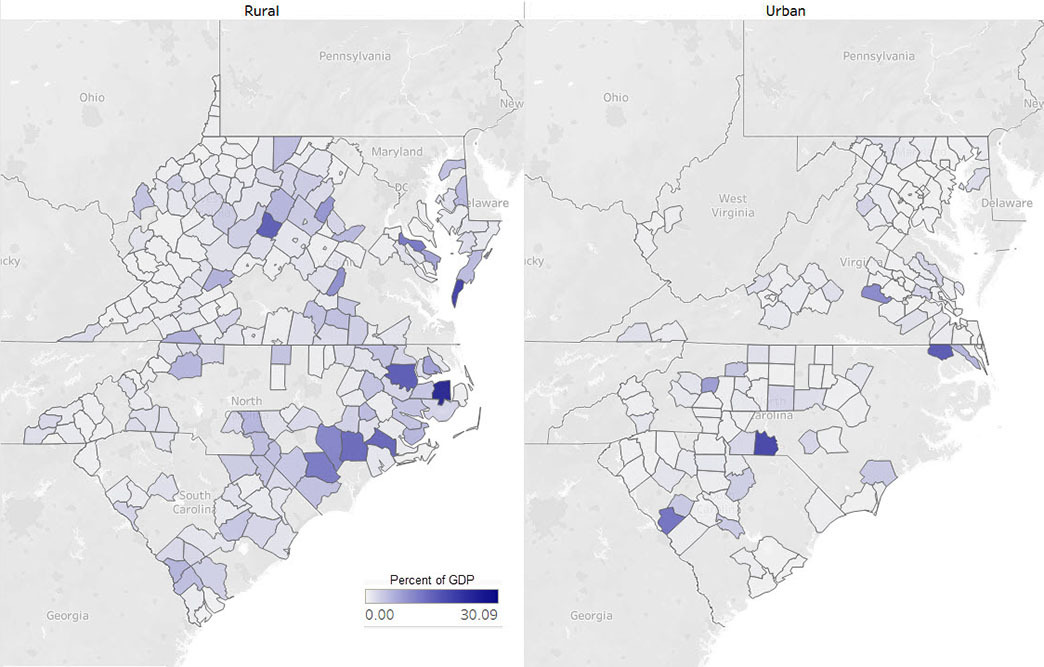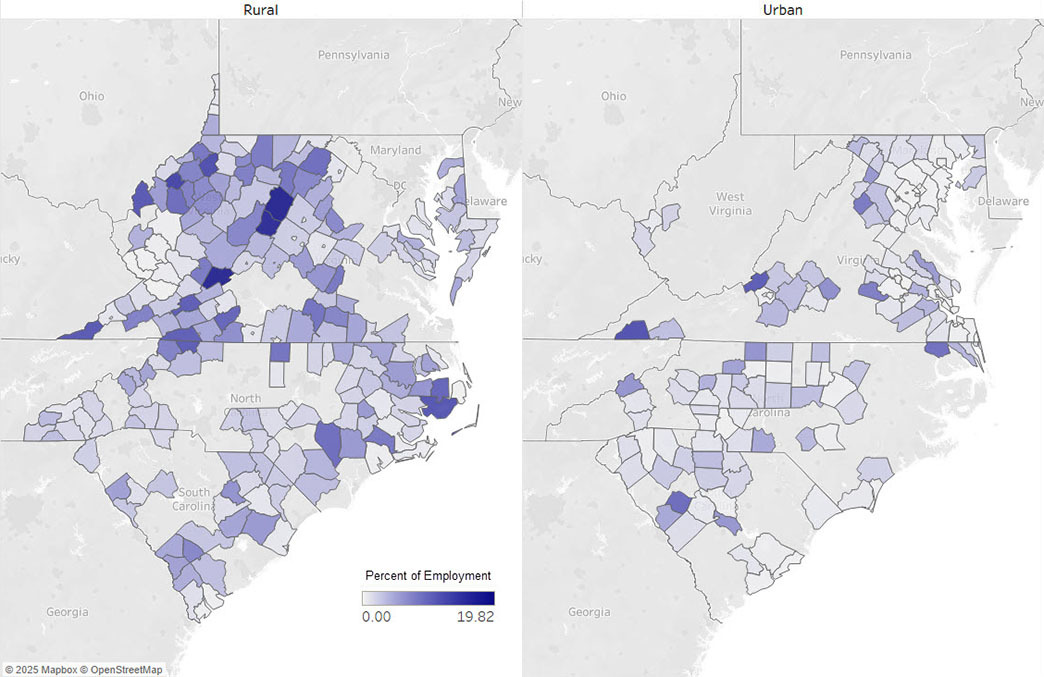Farming Creates Value and Employment for Rural Areas
From peanut farms in Virginia to cotton fields in South Carolina, open land lends itself to agricultural production. And, by definition, rural areas have more open land.1 The question is: Just how important is farming to rural areas?
The importance of agriculture to the Fifth District's economy can be assessed through its total production value, the number of jobs it provides, and the income it generates for rural farmers. In many rural areas, farming accounts for a large share of production. Nationally, agriculture production accounts for about 1 percent of total gross domestic product (GDP). But in the rural parts of our district, it accounts for an average of three times that amount, and in some places reaches nearly 30 percent of GDP.
Farming also provides a sizeable number of jobs in rural communities. Nationally, farm employment accounts for just 1.2 percent of total employment, but in the average rural county in our district, this number increases to over 4 percent and ranges up to 20 percent of total employment. However, while farming does provide production and jobs, the net income generated can be tenuous at best, particularly for smaller farms. This leaves many farm owners needing alternative forms of household income to keep operating.
Farming Creates Value in Rural Areas
Agriculture products that come from states in our district generated a total value of over $11.6 billion in 2023. North Carolina produced the largest value of agriculture products in our district at $6.2 billion, followed by Virginia and South Carolina at about $2.3 billion and $1.6 billion, respectively. However, agriculture products accounted for less than 1 percent of total GDP in every district state.
A map of agriculture's share of GDP shows that many rural areas derive a significant share of their total production value from agriculture. The map below shows the counties in which agriculture is driving production, which are largely in eastern parts of Virginia, North Carolina, and South Carolina. Those areas include counties such as Southampton on the eastern shore of Virginia and Tyrell in northeastern North Carolina. In the latter, agriculture products like livestock, corn, soybeans, and wheat accounted for over 30 percent of the county's GDP, the largest share in our district.
Some counties that are considered urban also had a large share of GDP coming from agriculture. One example is Anson County, N.C., (the darkest blue county on the right panel of the map) where agricultural production accounted for about 23 percent of GDP in 2023. Anson is considered urban because it is part of the Charlotte metropolitan statistical area (MSA), but with a total population of only around 22,000 people, the county comprises less than 8 percent of the MSA's population. The same is true for other dark blue urban counties in the map above — they tend to be the least populus counties in their respective metro area.
Farming Creates Jobs in Rural Areas
Looking at the total number of jobs created by farming tells a somewhat similar story as GDP. Nationally, farm employment is only a little more than 1 percent of total employment. But in some rural counties, it can account for as much as 20 percent of total employment.
The map also shows that farming can make up a sizable share of local employment even in places where agriculture doesn't contribute notably to production values. This is true for many counties in West Virginia and the western part of Virginia. There are a few reasons why this could be the case. First, some of these counties are small, so it doesn't take many jobs to make up a large share of the total. For example, in Highland County (one of the two dark blue counties in northwest Virginia), farm employment accounts for almost 19 percent of total employment with only 237 jobs. Another reason could be that there are other, more valuable goods and services being produced in the same county.
A third reason could be that the labor needed to farm the products created in certain locations is not directly proportional with the value of those products. The chart below indicates that this is true for many rural areas. For example, in Ashe County, N.C., farm employment was over 1,200 (more than 8 percent of total employment in the county), but the value of the goods only accounted for 1.4 percent of the county's GDP.
However, the positive relationship between value and employment holds for some counties in our district. The above chart also shows that in some places, like the combined area of Rockingham County and Harrisonburg City, Va., and Duplin and Sampson counties in North Carolina, farming creates a sizeable amount of value and jobs.
Farming Comes at a Cost
While farming produces valuable commodities and provides jobs in rural areas, the costs of running a farm can largely offset or even exceed the income that it generates. As indicated in the map below, the personal income generated by farming at the county level can be negative. The map shows this to be true in both rural and urban counties, and it is most prevalent across much of Virginia and West Virginia.
The map above also shows many counties where the net income generated from farming was close to zero. This doesn't mean that every farm is losing money or that workers are not being paid, but that the aggregate costs associated with farming erode much of the income generated. In fact, two reports from the United States Department of Agriculture (USDA) find that a typical farming household relies on nonfarm income to generate positive personal income. Another report shows that only the median commercial farm (those with revenues over $350,000) generate positive income from farming. Nationally, only about 14 percent of farms are considered commercial.
Lastly, some of the counties that produced the largest value of agricultural products are also the ones where personal income is the highest. For example, in Duplin County, N.C., the largest agricultural goods are hogs, poultry and eggs, soybeans, and corn. Not only are there several large commercial farms operating in the county, but according to the USDA, the vast majority of the total value comes from the livestock operations. It is not surprising, then, that Duplin County has some of the highest net income generated from farming.
Conclusion
Farming produces valuable agricultural goods and largely happens in rural areas. In many rural counties, agriculture accounts for a significant part of their GDP. Farming also creates employment opportunities in rural counties. Farming can be expensive, and the value of the goods does not always translate into positive net income for families, leaving them to rely on other sources of income to sustain operations. This is particularly true for smaller, non-commercial farms. While many of these farmers might not be able generate high, positive net income from farming alone, the income can be enough to sustain the farm, which creates products that the world needs.
For this analysis, a county with a rural-urban continuum code of 1 or 2 are considered "urban" and the rest are considered "rural".
Views expressed are those of the author(s) and do not necessarily reflect those of the Federal Reserve Bank of Richmond or the Federal Reserve System.




